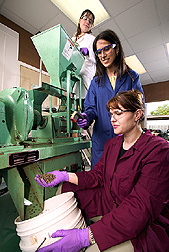This page has been archived and is being provided for reference purposes only. The page is no longer being updated, and therefore, links on the page may be invalid.
Read the magazine story to find out more. |
|
There's Nothing "Foul" About This Poultry Waste
By Erin PeabodyJuly 7, 2005
It could be considered the scientific equivalent of turning straw into gold. Chemists with the Agricultural Research Service have taken an abundant waste material--chicken manure--and turned it into a prized filtering product that can clean up polluted waters.
And the only thing needed to induce this impressive transformation: heat.
Isabel Lima and Wayne Marshall, researchers at the ARS Southern Regional Research Center in New Orleans, La., have found that charring poultry waste--burning it in an oxygen-free environment--yields a material with impressive surface area and spongelike qualities, ideal for mopping up pollutants.
The problem of animal waste disposal and management is a serious one in many countries. In the United States, food animals produce about 350 billion pounds of manure a year.
Some of that nutrient-rich waste can be used to fertilize fields. But soils can easily become too saturated with manure, causing excess nitrogen and phosphorus from the waste to leach into nearby rivers and waterways--which, in turn, causes algal blooms and other ecological disruption downstream.
Through their research, Lima and Marshall hoped to find a way to reduce the mass of burdensome animal waste and possibly discover a profitable, new use for it.
Exceeding the pair's expectations, the charred poultry litter is a powerful pollutant magnet. It's especially adept at grabbing heavy metals from wastewater, such as copper, cadmium and zinc, which are ordinarily tough to snag.
Charred filtering materials are also attractive in that they require less energy to produce than activated carbons, the current standard material for filtering pollutants from wastewater.
The ARS scientists think that their unique filtering material can be used in a variety of waste-treatment scenarios. They've produced pellets, granules and powders made from the char to accommodate different filtering structures, from water tanks to columns.
Read more about this research in the July issue of Agricultural Research magazine.
ARS is the U.S. Department of Agriculture's chief scientific research agency.

